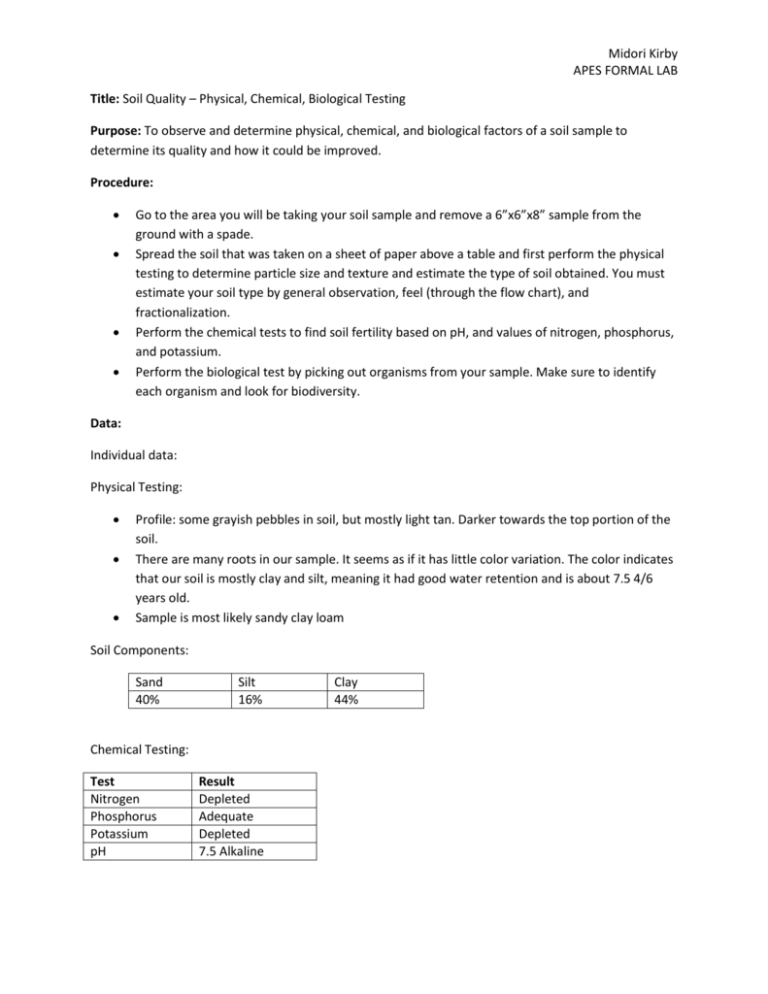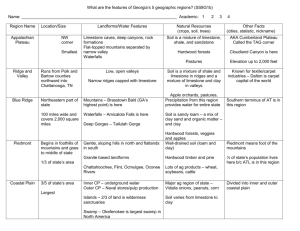Midori Kirby APES FORMAL LAB Title: Soil Quality – Physical
advertisement

Midori Kirby APES FORMAL LAB Title: Soil Quality – Physical, Chemical, Biological Testing Purpose: To observe and determine physical, chemical, and biological factors of a soil sample to determine its quality and how it could be improved. Procedure: Go to the area you will be taking your soil sample and remove a 6”x6”x8” sample from the ground with a spade. Spread the soil that was taken on a sheet of paper above a table and first perform the physical testing to determine particle size and texture and estimate the type of soil obtained. You must estimate your soil type by general observation, feel (through the flow chart), and fractionalization. Perform the chemical tests to find soil fertility based on pH, and values of nitrogen, phosphorus, and potassium. Perform the biological test by picking out organisms from your sample. Make sure to identify each organism and look for biodiversity. Data: Individual data: Physical Testing: Profile: some grayish pebbles in soil, but mostly light tan. Darker towards the top portion of the soil. There are many roots in our sample. It seems as if it has little color variation. The color indicates that our soil is mostly clay and silt, meaning it had good water retention and is about 7.5 4/6 years old. Sample is most likely sandy clay loam Soil Components: Sand 40% Silt 16% Chemical Testing: Test Nitrogen Phosphorus Potassium pH Result Depleted Adequate Depleted 7.5 Alkaline Clay 44% Midori Kirby APES FORMAL LAB Biological Test: From our sample there were 18 earthworms found. No other organism was able to be found. This may have been because the sample was depleted in Nitrogen and Potassium, decreasing the soil quality and fertility. Data from whole class: GROUP Part 1 Soil Profile 1 Part 3 Soil Texture Part 4 Soil Texture Part 5 Fertility Part 6 Biodiversity Mostly sand, Gritty, light clay on brown color bottom, organic material on top Sandy clay loam Sandy loam Ants: 9 Worms: 4 Spider: 1 2 lots of silt and organic material Dark brown color, very wet and malleable, neither gritty nor smooth Clay loam silt 3 Some gray patches in soil, inside is darker than the outside. Very clay-ish and chunky Mostly sand & silt, easily broken apart Lots of roots, Sandy clay dense clay, small loam variation of color Clay Clumps of clay, dark brown soil color, mainly smaller particles, slightly damp and crumbly Reddish-Brown chunks of clay, in large particles. Sandy clay loam Loam Silty Clay Loam Silty Clay Loam NitrogenDepleted PhosphorousAdequate PotassiumSufficient pH- 7.5 Nitrogendepleted Phosphorusdeficient Potassiumsufficient pH- 7.5 NitrogenDepleted PhosphorousAdequate Potassium: Depleted pH- 7.5 Nitrogendepleted Phosphorousadequate Potassiumadequate pH- 6.5 NitrogenDepleted PhosphorousDeficient PotassiumAdequate pH- 6.5 4 5 Mostly silt and clay. Easily moldable and damp. Part 2 General Observations Millipedes: 2 Earthworms: 18 Pill Bugs: 2 Worms: 2 Beetle: 1 Millipede: 1 Ant: 1 Worms: 6 Millipede: 1 Midori Kirby APES FORMAL LAB 6 Mostly silt Dark brown with Loam Loam NitrogenNo with small lighter shades of Depleted organisms amount of clay. Held Phosphorus- found clay below. together in Depleted Some clumps. Several Potassium clumps and small roots in Sufficient damp. soil. Our group ( group 3 ) had less biodiversity than most of the other groups but had a large quantity of earth worms. This may have been because our sample had very little decomposed material on the surface which often times harvests organisms like ants and beetles. Analysis: 1. Humus provides nutrients along with metals and minerals. It also contains microorganisms that help breakdown waste and absorb nutrients from soil. 2. Top soil components are mainly minerals, organic matter, water and air. We are losing topsoil at an alarming rate mostly because of agricultural reasons like frequent tilling of land. It is also caused by deforestation and the decrease in vegetation that prevents erosion. A way to reduce topsoil loss is to not till land between planting, leaving crop stubble to reduce erosion, and planting new seeds between crop stubble. 3. Layers in a soil profile: HORIZONS In the North Carolina Piedmont area, the surface layer is a dark gray sandy loam while the subsoil layer contains red clay with clay loam. 4. pH is important because it will influence what kind of organisms that will live in the soil. pH allows nutrients to become soluble in water and be absorbed by roots. When pH is too high or too low, it becomes infertile because it cannot sustain life for organisms or gain certain nutrients even if they are present in the soil because most nutrients are less soluble in basic soil conditions. 5. Some natural sources of nitrogen, potassium, and phosphorus: Nitrogen is found abundantly in the atmosphere. Potassium and phosphorus both are found in decaying or decomposed organisms. 6. Atmospheric Nitrogen is converted into ammonia, a form that plants can easily absorb through their roots by nitrogen fixation. 7. Living organisms use nitrogen, potassium, and phosphorus to produce complex organic molecules and nucleic acid and cell energy generation. There nutrients also play a role in nervous, circulatory, and neurological system processes. 8. Our sample soil was not very fertile because it was depleted in nitrogen and potassium, which would stunt the photosynthetic process and cause vegetation to have yellowish leaves that die off near the bottom. It also had a pH of 7.5 meaning those primary nutrients would not be able to dissolve more readily as it would be able to in a more acidic condition. 9. Because our soil type was sandy clay loam or clay, and the pH was 7.5, it could probably only sustain grasses and landscaping vegetation. Most fruit based plants need a more acidic soil type to be able to flourish. Midori Kirby APES FORMAL LAB 10. Our soil sample had very little soil diversity and consisted of only earthworms. Because we took our sample from an area that had very little to no vegetation, it may have been unhealthy, infertile soil, which organisms would not want to live in. 11. What could have gone wrong in the experiment? We could have missed other organisms in the soil which would affect our data of biodiversity. Also when taking the percentages of soil composition we may not have allowed the sample to settle out completely in the graduated cylinder, giving up an inaccurate description of the soil composition. Conclusion: What improvements should be made to your soil? Fertilizer can be added to supplement the depleted nutrients of nitrogen and potassium. It is also a pretty basic soil type so by increasing its acidity it would be able to support more acid loving plants such as blueberries, azaleas, etc. We could also introduce a larger variety of organisms to the area to help break down decaying organic material to increase the fertility of the soil.




